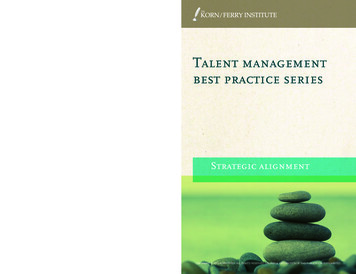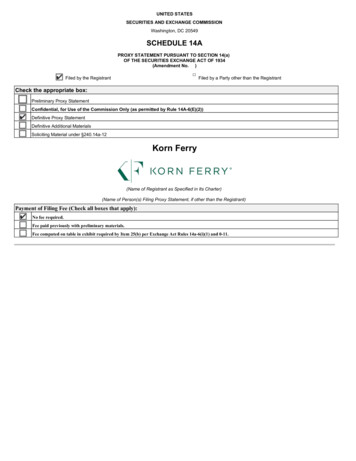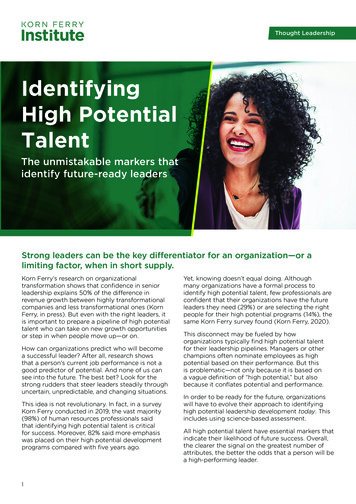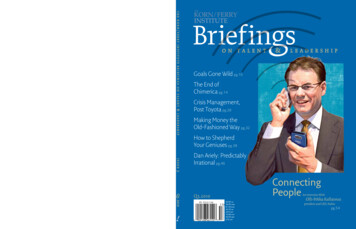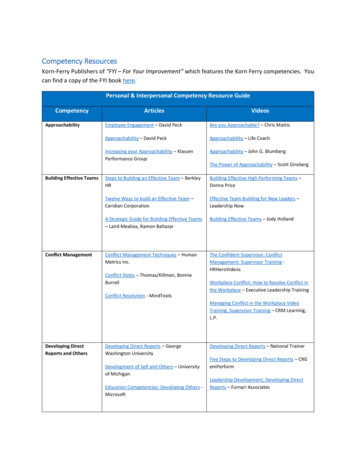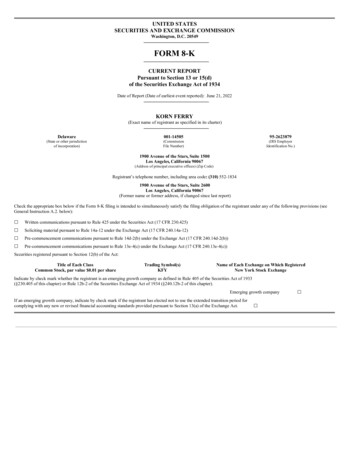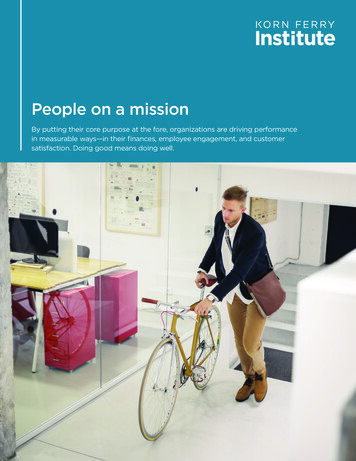
Transcription
People on a missionBy putting their core purpose at the fore, organizations are driving performancein measurable ways—in their finances, employee engagement, and customersatisfaction. Doing good means doing well.
How purpose drives performance.Purpose is a fundamental component of afulfilling life and a successful organization.People with a positive, energizing purposetend to be focused, optimistic, andsuccessful. Great purposes inspire bothpeople and organizations to do great things.Purpose drives performance. Period. Individuals with aclear personal purpose draw on their deepest energies andperform to the best of their abilities. When an organizationhas a clear purpose, it unleashes the power and drive of theentire workforce, harnessing and focusing that combinedeffort in one aligned direction.To be sure, there are two sides to purpose. In today’sfractious world, some people find purpose in extreme, hatefulideologies. At the same time, a new capitalism is emergingwhere purpose-driven organizations are engaging people ina profound manner, contributing to society and establishingnew criteria for organizational success.The results are impressive, with multiple studies indicatingthat purpose-driven organizations generate superiorperformance, greater stakeholder satisfaction, and increasedsustainability: Such organizations in the consumer sector achieveda compound annual growth rate of 9.85% comparedto their peers’ rate of 2.4% in the S&P 500 ConsumerSector from 2011 to 2015, Korn Ferry has found. 1 90% of executives say a commitment to purposedriven leadership produces long-term financialbenefits (Korn Ferry Hay Group Survey 2016). Purpose-driven companies with humanistic valuesoutperformed the S&P 500 by 14 times over 15 years(Sisodia, Sheth, and Wolfe 2007). A “strong, well-communicated purpose” cancontribute up to a 17% improvement in financialperformance (Burson-Marsteller and IMD BusinessSchool 2015). Workers with a “purpose orientation” report greaterjob fulfillment, “do significantly better” in theirperformance evaluations, and are much more likelyto promote their employers to others (Imperativeand New York University2015).As more companies promote their purpose in their brandsand external images, an important and illuminating story isemerging about the guiding philosophies and best practicesof companies thriving and driving sustainable performancefrom a deep-rooted commitment to purpose. To betterunderstand the internal practices of these organizations, KornFerry interviewed 30 founders, CEOs, and senior executivesat consumer companies with visible and authentic purposes,engaged employees, customer-oriented cultures, and strongfinancial results; 20 organizations in total participated in thestudy. The top brands participating included: Chobani, TOMS,Warby Parker, Etsy, KIND Healthy Snacks, West Elm, andothers.The firm’s research identified this key insight: Althoughthese brands are celebrated for their external images,customer engagement, and positive impact in the world, theircommitments to people and purpose inside their companiesfuel their success. Korn Ferry identified four key conditionsthat make up the foundation of thriving purpose-drivenorganizations: The CEO and others lead from values and purpose tomake decisions. People are the top priority. Companies invest inpeople to drive growth.1 Korn Ferry compared the 2011-15 revenue growth of purpose-driven organizations with their S&P 500 consumer product group peers, including 71 publicly listed companies that the firmidentified. A composite purpose-driven organization also was created on the basis of financial data from 39 organizations the firm identified as having a deeply rooted purpose that fuelsbusiness growth.2
People On A Mission Culture is reflective of human communities, as people bring their whole selves to work. Enabling Practices exist in all parts of the organization, revealing a pervasive commitment to purpose.Given the success of such organizations and the needs in the world, interest in the purpose-driven concept has exploded.Some organizations focus on the short term, using purpose in their brands to achieve other immediate goals. But the firmhas found that more businesses are moving to lead with missions sufficiently expansive to include all their stakeholders andto fuel their businesses with purpose. Such commitments can be highly beneficial, not only in their greater contributions tobroader society but also in creating a humane culture and generating engagement and fulfillment among employees.But imbuing an organization with a core purpose can be hard work. Top leaders must respect their organizations’ originswhile also ensuring that purpose and people are at the center of the companies’ culture and identity. Hiring practices,employee development, and internal communication must focus on melding a company’s external purpose with the innerpurpose of individual employees. Done authentically, purpose can be a powerful tool to generate individual and organizationalexcellence.“Establishing a line of sight into organizational purpose is a leader’s job, not just once as part of a ‘visioning’ exercise butrather continually, incorporating purpose into every moment and process of leadership,” said Kevin Cashman, a senior partnerand executive leadership expert with the firm. “To optimally engage business performance, personal, team and organizationalpurpose must be aligned.”The aim of this study is to provide useful insights for organizations striving to become more purpose-driven and to individualswho are seeking to fuse their purpose with that of their organizations to become more effective leaders.The power of purpose: what it can,can’t do for organizationsKorn Ferry interviewed 20 organizations showing highperformance driven by purpose, mission. They provide asnapshot (bars show percentage of affirmative respondents)of what these factors strongly support for them, and wherethey have less effect.It has people-pulling powerAttracting talentAttracting younger employeesAttracting new customersIt engages, retainsEngaging employees100Engaging younger employees10095Retaining customers79Dealing with suppliers58Maintaining supportin controversiesCharging premiumpricesManaging legal,regulatory risk42323
A new frontier.Purpose-driven organizations are thrivingon many levels. They are producing superiorfinancial results, increased employeeengagement, customer loyalty, and societalbenefits from healthful products to inclusivecommunities. These positive outcomes haveled other organizations to emulate them,pushing purpose into consideration for thecorporate mainstream.Traditional consumer companies in the packaged goodssector are growing via purpose too, with some acquiringtheir way there: Campbell Soup Co. bought Plum Organicsin 2013; General Mills purchased Annie’s Homegrown in 2014;and Pinnacle Foods acquired Boulder Brands in 2016, amongothers. With the September announcement of Unilever’splans to buy Seventh Generation, purpose-driven brands aregaining significant visibility. Unfortunately, some of thesemoves are straightforward brand acquisitions; successfulintegration of these businesses requires recognition of thesouls of the purchased organizations—the people who havebreathed life into them.“There are so many purpose-driven success stories:Burt’s Bees, TOMS, Warby Parker, Plum Organics, SeventhGeneration,” said John Replogle, Seventh GenerationPresident and CEO. “What was once a grassroots movementhas grown into something much more substantial. Now youhear [purpose] in all the key speeches of the enlightenedleaders, like Jeff Immelt at General Electric and Paul Polmanat Unilever.”The rise of purpose-driven organizations began in the1960s and 1970s when some businesses found themselvesunder public fire for damage to the environment, hazardousworking conditions, and unsafe products. That promptedthe corporate socially responsibility movement, in whichcompanies took into account their societal impacts andcommitted to making positive contributions to the world.The topic generates sufficient interest that it has new mediamessengers, too. “We felt there wasn’t an industry publicationaggregating best practices to bring the sustainable businessmovement into a cohesive movement,” said Meghan FrenchDunbar. She co-founded Conscious Company Magazine in2014.As a measure of purpose’s expansion, 30 US states andWashington, DC, have recognized it as of September 2015and are offering companies new legal standing, incorporationas a Certified B Corporation. That’s a status conferred onan organization with a positive impact on the world, asmeasured by an independent third party. B Lab, a nonprofitthat provides B Corporation accreditations, has certified 1,966of them in 50 countries as of November 2016. Through BLab’s free online tool, the B Impact Assessment, more than50,000 business globally have registered to measure theirimpact in using “business as a force for good.”4The purpose-driven ethos is broader and deeper still,experts say. Social responsibility focuses on externalcommitments to society. But in authentic purpose-drivenorganizations, leaders insist that purpose drives strategy,organizational structure, decision making, recruitment andemployee development, as well as customer and stakeholderrelationships. Its influence permeates all aspects of thecompany.Jay Coen Gilbert, co-founder of B Lab, has witnesseda progression from “a compliance approach to socialresponsibility.” He said he also sees an “opportunity-basedapproach” in which organizations connect their externalpurposes to their employees’ internal purposes.“For many B Corps, purpose is seen as a motivator,” Gilbertsaid. “The companies that are doing the best are the ones
People On A Mission where the company is serving a higher purpose, and everyone in the company, at every level, feels personally connected tothat purpose and how their job impacts the world.”Given the success of purpose-driven organizations and their cultures’ allure to all types of employees—particularly those inthe millennial generation—the movement will likely grow stronger in years ahead. “Millennials want a meaningful job, and theywant to be treated well,” said Dunbar of Conscious Company magazine.KNOW THEM BY THEIR WORDSCompanies strive to summarize their core purpose instatements like these:“To provide better food for more people.”“To re-imagine commerce in ways that build a morefulfilling and lasting world.”“To do the kind thing for your body, your taste buds, andyour world. We’re on a mission to make the world a littlekinder, one snack and act at a time.”—Etsy—Chobani—KIND“Spreading the power of optimism.”—Life Is Good“The highest standards of corporate behavior towardseveryone we work with, the communities we touch, andthe environment on which we have an impact.”—Unilever“To inspire a consumer revolution that nurtures the healthof the next seven generations.”—Seventh Generation‘Leading industry to love the world.”—Interface“A life outdoors is a life well lived.”—REI“We deliver nourishing, organic food to our nation’s littleones and to raise awareness and advance solutions forchildhood hunger and malnutrition in the United States.”—Plum OrganicsPurpose drives performance.A Korn Ferry analysis shows how purpose-driven, consumer sector companies outperformed their peers in the period 2011-15.The compound annual growth rate for purpose-driven firms in this period was 9.85% versus 2.4% for sector peers. Purposedriven firms’ average median revenue (in millions US) in the period was 465.01, versus 414.64 for sector peers.Purpose-driven organizations60%S&P 500 consumer sector50%40%30%20%10%0%-10%201120122013201420155
LeadershipCEOs loom large in purpose-drivenorganizations. They are the chief advocatesof their organizations’ core purposes.Typically, they are inspired to be part ofsomething larger than themselves, and theywork hard to affect others’ lives in positiveways. They strive to maintain a laser-likefocus on serving all stakeholders (notjust shareholders), and the greater world.Through their communications, actions, andbehaviors, these leaders set clear examplesof how their organizations pursue purposewhile adhering to shared values. “If westay exceptionally true to the foundation ofthis company, we will continue to do reallywell,” said Jim Alling, CEO of TOMS. “Wedo well when people want to read past thesuperficial layer. The minute we become asell-out brand is the minute we die.”Chad Dickerson, CEO of Etsy, said, “Being a leader is notabout you, it’s about everyone else. It takes humility andvulnerability. Being a CEO is the most humbling job, as thereare so many other people to help make successful.”To be effective, CEOs must also marshal the support of theirboards and communicate to them how the focus on purposeimproves every measure of organizational performance.When confronted with situations in which financialexpediency conflicts with organization values, CEOs ofpurpose-driven organizations try courageously to advocateand adhere to purpose and core values. “We assembled ourboard so that they would help us make decisions that don’thurt the company’s mid- and long-term value,” said Audrey6Robertson, executive vice president of culture and strategicassistant to the CEO of The Container Store. Dan Hendrix,CEO of Interface, said of purpose, “It takes courage to stickwith it. As a public company, it was very difficult at first Now today, you get dinged if you don’t have a sustainabilityplatform. It’s easier today, as the board is involved andsupportive.”A common theme of the organizations in Korn Ferry’s studyis how their missions are larger than the organizationsthemselves. Many will succeed only if they bring others withthem. Interface recently evolved its mission from a net neutralto that of a positive impact. Their mission statement of,“Leading industry to love the world,” requires them to enlistothers on their journey in service of the planet. Jim Scarfone,executive vice president of human resources at KIND, makerof healthful snacks, observed that, “Even if we influence oneor two companies, that’s huge.” These organizations havea common vision of businesses together rising on a tide ofpositive impact. “TOMS started with a purpose and grew intoa company,” said Alling, its CEO. “If you ask why TOMS exists,our employees won’t hesitate. They might say improving livesthrough business, or using business to improve lives.”Transparency, humility, and valuing employees are hallmarksof purpose-driven CEOs. They reach out to others often,visiting locations, holding town halls, and simply walking thehalls to talk with people.“The saying ‘nothing personal, it’s business’ is such adamaging idea,” said Neil Grimmer, co-founder and chairmanof Plum Organics, the top organic baby food brand in the USin sales. “We love the idea of turning it on its head: Businessis personal, lead with your heart, show up with your moralcompass, your compassion for employees, peers. Whenyou do that, you get a different outcome. A stronger socialbenefit, a more connected and passionate workforce.”Hamdi Ulukaya, founder and CEO of the booming yogurtmaker Chobani, made headlines in April 2016 when he gave
People On A Mission employees 10% of the company’s shares. Since foundingChobani in 2005, Ulukaya has consistently demonstrateda commitment to employees. “Everyone is valued andacknowledged,” said Grace Zuncic, Chobani’s senior vicepresident of corporate development and strategy. “Hamdi isvery responsive to people and deeply believes our successcomes from them. The influence he has on culture andhis ability to build one team from an unbelievably diverseworkforce is remarkable.”Many CEOs and other top leaders at purpose-drivenorganizations make it a priority to chat with new employeesto learn about them both as workers and as people andto help them connect their personal aspirations to theorganizations’ purposes and values. Although this is easierto do in smaller companies, CEOs in purpose-drivencompanies, regardless of organization size, commit to internalcommunication and connection with employees. The topleaders “sit down with all new recruits for an hour to get toknow them and to introduce them to our values and culture,”said Ralph Carlton, King Arthur Flour co-CEO and CFO.“We send people off into the company with a message thatmatters.”PURPOSEFUL LEADERSHIPLeadership isn’t easy in any organization. But itshallmarks in purpose-driven companies include: CEOs who seek to be humble, confident,resilient, and courageous Boards committed to purpose to sustainsuccess Long-term strategy that honors theorganization’s values and heritage Their leaders’ vision is seen and executed alwayswith purpose in mindBefore they can head up a purpose-driven organization,leaders need to discover their own purposes and values, oftenafter a personal journey and as the culmination of variedlife experiences. Replogle of Seventh Generation recalls hisepiphany one Saturday when he realized he was spendingtoo little time with his children. He resolved to lead a morepurposeful and focused life, after also experiencing what thelate Ray Anderson—an industrialist, environmentalist, andfounder of Interface—called “a spear in the chest moment.”Replogle recalled: “I decided to leave my current job andmove to a place where I could live my values more fully. Thereare different ways to define success in business. I wantedto invest in people, think about the planet, and work incompanies that advance health and well-being.”When Korn Ferry asked the leaders interviewed in thisresearch, 100% responded that operating from purposemakes them more resilient. “It gives you strength to keepgoing in the face of any adversity,” said Giannella Alvarez,CEO of Harmless Harvest.7
The KIND storyDaniel Lubetzky, the founder and CEO of the snack food company KIND, is an example of an entrepreneurwho created an enterprise fueled by his personal experiences, worldview, and humane values, not by a desirefor wealth. He is the son of a Holocaust survivor and grew up hearing stories from his father, who survived theDachau concentration camp, in part because a German soldier tossed him a potato when no one was looking.This simple act of kindness, more than the sustenance the potato offered, gave his father the will to continue,Lubetzky recalled. “What is remarkable is that he was able to recall all that darkness and yet stay positive andhighlight instances of kindness amidst some of the saddest chapters in human history,” he says.When Lubetzky formed KIND, his father’s lessons became central to the organization’s purpose.KIND’s stated purpose is “to help people do kind things for their body, their taste buds, and their world.” Thethird pillar—to do “kind things for their world”—led it to create the KIND Movement, which it describes as “acollaborative effort between KIND and our community to make the world a little kinder.”The company brings its mission to life through its brand, philanthropy, and culture. Consider its efforts with theKIND Foundation. That’s the company’s charitable arm, which encourages people to nominate social causes thatare worthy of charitable support. It allows people to vote for causes that inspire them the most. Every month,the cause that receives the most votes is awarded a 10,000 grant. The foundation’s KIND People programcelebrates individuals who have transformed their communities through kindness. In its inaugural year, theprogram will award more than 1 million in prizes to individuals helping those most in need.In addition, KIND created the #Kindawesome program to spot and reward acts of kindness. Under the program,anyone who spots an act of kindness can visit a digital hub and send an electronic #kindawesome card to thedoer of the kindness. The card is redeemable for a KIND snack and another #kindawesome card to pass on. AllKIND team members also receive physical #kindawesome cards to celebrate kindness in their daily lives.“What’s magical about the #kindawesome cards is that we’re not interrupting the act of kindness at the momentit happens,” said Lubetzky. “Only after the act is complete do we then approach and celebrate the person.”Lubetzky embodies the brand and its purpose. The author of the New York Times bestseller, Do the KIND Thing,he started the company in 2004. It now employs nearly 600 people, and its products are sold through morethan 150,000 stores. The company generated a 111% compound annual growth rate over the last five years andhas sold more than one billion KIND bars since its inception. Since day one, Lubetzky has focused on nurturinga culture of empathy. “Daniel is a humanitarian who happens to be a great business person,” said Elle Lanning,KIND chief of staff.Lubetzky recalls his early career as a key motivator: “My early years as an entrepreneur also played a rolein strengthening my purpose and resolve to build bridges. I started my first company in 1994. It was calledPeaceWorks, and it fostered economic cooperation among Israelis, Palestinians, Turks, and Egyptians in thepursuit of making delicious foods. During this era, challenges were common. I made a lot of mistakes, and I wasalways worrying about whether I’d make payroll. The thought of giving up and becoming a lawyer—which I hadgone to school for—often crossed my mind. But my purpose kept me going. In fact, it became a source of nearinvincibility. Whenever I reminded myself why I had started PeaceWorks—to help build a footing for peace—Irealized failure was not an option.”
People On A Mission People first.Purpose-driven companies differ fromtraditional organizations in the way theyengage employees and interact withthe outside world. As a result, theseorganizations employ different peoplepractices in a variety of areas, includingrecruitment, leadership development,employee communication, employeeevaluations, and procurement of productsand services.The commitment to purpose comes to life in the everydaydecisions that are made by leaders and others acrossthe organization. If there is a clear, guiding purpose anda commitment to living by their values, the organizationgenerally makes the right decisions when under pressure.Recruitment and onboarding.Purpose-driven organizations typically view their employeesmore holistically than traditional businesses do. They,for example, aim to hire people who connect with theorganization’s purpose and values, rather than focusingexclusively on business skills and prior experience. Oncehired, employees are treated humanely.“Hire and promote first on the basis of integrity; second,motivation; third, capacity; fourth, understanding; fifth,knowledge; and last and least, experience,” Dee Hock,founder and former CEO of Visa, famously said. “Withoutintegrity, motivation is dangerous; without motivation,capacity is impotent; without capacity, understanding islimited; without understanding, knowledge is meaningless;without knowledge, experience is blind. Experience is easyto provide and quickly put to good use by people with all theother qualities.”Carlton of King Arthur Flour said, “We employ the wholeperson. It’s a deliberate approach to people management.We care about who people are and how people are.” Duringinterviews at Seventh Generation, prospective employees areasked, “How are you making your values come to life whereyou are?” said Joey Bergstein, general manager and chiefmarketing officer. “We interview for values and connection toour mission. We want to ensure we have alignment.”Onboarding process is key, too. It “has gotten significantlymore rigorous as we’ve grown,” said Neil Blumenthal, cofounder and co-CEO of Warby Parker. “So when anyonecomes in, we spend a full week telling them about thecompany, regardless of level. You learn about the history ofthe company, the core values, why the core values matter, ourannual goals, our three-year plan. If you understand wherewe’re trying to go and how you want to get there, and why,then you can always make informed decisions, whether or notyou have a very directive management.”PRIORITY NO. 1: PEOPLEIn purpose-driven organizations, people are prime, andinvesting in them is seen as driving growth: Hiring the right people is key and the criticalstart. The mission then is reinforced throughdevelopment, communication, andaccountability. Leaders seek to assist individuals in aligningtheir purposes with those of the organizations.This drives engagement.9
Leadership development.When Korn Ferry asked participants in this research abouttheir commitment to investing in their people, 72% ofparticipants cited leadership development as a key area; 28%cited leadership development but recognized they need toinvest more in it. A theme developed that these organizationsemploy customized leadership development programs thatspeak to their companies’ values and missions and to theindividual. The goal is to build leaders who are grounded intheir own purposes and rooted in the organizations’ purposesand cultures. This gives them a rock-solid base to developleadership competencies and skills vital to their organizations.“We work with managers to develop broad leadership skills,”said Carlton of King Arthur Flour. “We have a multi-yearcommitment to developing people. As we’ve grown, we’vebuilt core competencies within the business.”West Elm screens high-potential talent for purpose, thenprovides a path for development. “We move people laterallyfor training and development, and we integrate that withtalent acquisition, so that people are on a path when theycome in the door,” said West Elm President Jim Brett.Organizations that lack an overarching purpose can be drivenby performance outcomes. When performance becomes thepurpose, organizations may emphasize short-term financialresults, a focus that can diminish employee engagementand lead to decisions that undermine the organization’ssustainability.Most people find purpose and meaning through theirrelationships, spiritual beliefs, and values. Althoughtraditional workplaces engage people to a certain level, theyonly rarely tap into an individual’s deeper values and sense ofpurpose. In contrast, experts say, purpose-driven companiesvalue highly connecting their purpose with those of theirindividual employees. This creates higher engagementas workers see themselves as communities in service tosociety and its broader missions. Employees discover deepermotivation and develop stronger collegial relationships.They feel comfortable bringing their “whole selves” to work.They work with passion and commitment. Purpose-drivenemployees tap into what Korn Ferry Hay Group describes as“discretionary energy.” Their purpose, combined with otherkey aspects in optimal working conditions, encourages themto go above what’s expected and accomplish more (Lewisand Hezlett 2016).Research clearly shows that people are more engaged inpurpose-driven organizations: 93% of respondents to aKorn Ferry survey in spring 2016 agreed with the statementthat “embracing the mission/purpose of your organizationincreases employee productivity.” According to a Gallup pollconducted in 2015, the percentage of US workers engagedin their jobs averaged 32%. Although 50.8% of employees10were “not engaged,” 17.2% were “actively disengaged.” Of thecompanies interviews in this Korn Ferry study that sharedtheir employee engagement scores, the average was 90%.Purpose-driven organizations tend to foster an ownershipmindset among employees, who are empowered to addressissues and solve problems in a manner consistent with theorganization’s purpose and values. As a result, workers inpurpose-driven organizations will go the proverbial extramile when confronted with a deadline or sudden opportunity.“Our associates come to West Elm to make an impact. Theway people come together when we have a deadline showsthis. Suppliers are always telling us our team is amazing.” saidWest Elm’s Brett.Transparency is critical.Transparency in actions and communication is critical topurpose-driven organizations, the leaders said, becauseit enables employees and stakeholders to see first-handhow purpose and values inform decisions, processes, andprocedures. Transparency is essential to generating employeeengagement and buy-in.“We release a weekly newsletter Chobani This Week, hostroutine town halls at the plants, and convene management inoffsite meetings throughout the year. We want to make surepeople have a good sense of what’s happening and wherewe’re headed,” said Chobani’s Zuncic.Similarly, at King Arthur, “we are strong advocates oftransparency,” said Carlton. “We tend to over-discloseinformation.”Customers also increasingly are demanding greatertransparency from the companies they do business with, adevelopment that is generally welcomed by purpose-drivenorganizations. That’s because it provides an opportunity todifferentiate themselves from more traditional organizations.Measure what matters.At purpose-driven organizations, employees are measuredand rewarded based on their holistic contributions to theorganization. Their performance evaluations account forthe employee’s overall performance and positive impact onthe culture, people and purpose, not simply the businessperformance.“Our commitment to purpose means we define successthrough our values, not just profits. Our conversation andsuccess definition is focused on four dimensions; employees,co-op members, society and the business.” said Eric Artz,CFO and COO of REI.
People On A Mission John LeBoutillier, president, Unilever Canada, noted: “Ourratings have evolved. We focus on the organizational impactas much as the numbers. We’re much more concerned withthe how, not just the what, during performance reviews. We’removing to more fluid feedback every day versus reviewsevery six months.”Supply chains.An important place organizations’ commitment sho
to their peers' rate of 2.4% in the S&P 500 Consumer Sector from 2011 to 2015, Korn Ferry has found. 1 90% of executives say a commitment to purpose-driven leadership produces long-term financial benefits (Korn Ferry Hay Group Survey 2016). Purpose-driven companies with humanistic values outperformed the S&P 500 by 14 times over 15 years
